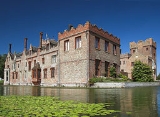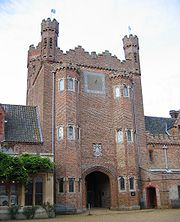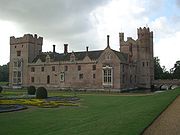
Oxburgh Hall
Encyclopedia
Oxburgh Hall is a moated country house in Oxborough
, Norfolk
, England
, today in the hands of the National Trust
. Built around 1482 by Sir Edmund Bedingfeld, Oxburgh has always been a family home, not a fortress. The manor
of Oxborough came to the Bedingfeld family by marriage before 1446, and the house has been continuously inhabited by them since their construction of it in 1482, the date of Edward Bedingfeld's licence to crenellate.
 A fine example of a late medieval, inward-facing great house, Oxburgh stands within a square moat about 75 metres on each side, and was originally enclosed; the hall range facing the gatehouse
A fine example of a late medieval, inward-facing great house, Oxburgh stands within a square moat about 75 metres on each side, and was originally enclosed; the hall range facing the gatehouse
was pulled down in 1772 for Sir Richard Bedingfeld, providing a more open U-shaped house, with the open end of the U facing south. The entrance, reached by a three-arched bridge on the north side, is dramatised by a grand fortified gatehouse, evoking the owner's power and prestige, though as fortification its value is largely symbolic; it is flanked by tall polygonal towers rising in seven tiers, with symmetrical wings extending either side that reveal nothing on the exterior of their differing internal arrangements. About 1835 the open end of the U was filled in with a picturesque, by no means archaeologically correct range that recreated the central courtyard. Other Victorian additions include the Flemish
-style stepped gables, the massive southeast tower, the oriel windows overhanging the moat (illustration, left) and terracotta chimneys. Four towers were added to the walled kitchen garden.
The hall is well known for its priest hole
. Due to the Catholic
faith of the Bedingfeld family, a Catholic priest may have had to hide within the small disguised room in the event of a raid. The room is reached via a trapdoor, which when closed blends in with the tiled floor. Unlike many similar priest holes, the one at Oxburgh is open to visitors.
The hall is also notable for its needlework hangings by Mary, Queen of Scots. She worked on these while in the custody of the Earl of Shrewsbury
, following her escape to England. Other hangings on display were produced by Bess of Hardwick
.
The estate has a number of woodland walks, including a 'Woodland Explorer' trail.
Oxburgh Hall is a popular location for film and television series, including brief appearances in the Dad's Army
episode "Museum Piece
", and later in You Rang, M'Lord?
. It was the major setting for the 1994 television dramatisation of Love on a Branch Line
, a novel
by John Hadfield
.

Oxborough
Oxborough is a village and civil parish in the English county of Norfolk.It covers an area of and had a population of 240 in 106 households as of the 2001 census. For the purposes of local government, it falls within the district of Breckland....
, Norfolk
Norfolk
Norfolk is a low-lying county in the East of England. It has borders with Lincolnshire to the west, Cambridgeshire to the west and southwest and Suffolk to the south. Its northern and eastern boundaries are the North Sea coast and to the north-west the county is bordered by The Wash. The county...
, England
England
England is a country that is part of the United Kingdom. It shares land borders with Scotland to the north and Wales to the west; the Irish Sea is to the north west, the Celtic Sea to the south west, with the North Sea to the east and the English Channel to the south separating it from continental...
, today in the hands of the National Trust
National Trust for Places of Historic Interest or Natural Beauty
The National Trust for Places of Historic Interest or Natural Beauty, usually known as the National Trust, is a conservation organisation in England, Wales and Northern Ireland...
. Built around 1482 by Sir Edmund Bedingfeld, Oxburgh has always been a family home, not a fortress. The manor
Lord of the Manor
The Lordship of a Manor is recognised today in England and Wales as a form of property and one of three elements of a manor that may exist separately or be combined and may be held in moieties...
of Oxborough came to the Bedingfeld family by marriage before 1446, and the house has been continuously inhabited by them since their construction of it in 1482, the date of Edward Bedingfeld's licence to crenellate.
Description

Gatehouse
A gatehouse, in architectural terminology, is a building enclosing or accompanying a gateway for a castle, manor house, fort, town or similar buildings of importance.-History:...
was pulled down in 1772 for Sir Richard Bedingfeld, providing a more open U-shaped house, with the open end of the U facing south. The entrance, reached by a three-arched bridge on the north side, is dramatised by a grand fortified gatehouse, evoking the owner's power and prestige, though as fortification its value is largely symbolic; it is flanked by tall polygonal towers rising in seven tiers, with symmetrical wings extending either side that reveal nothing on the exterior of their differing internal arrangements. About 1835 the open end of the U was filled in with a picturesque, by no means archaeologically correct range that recreated the central courtyard. Other Victorian additions include the Flemish
Flanders
Flanders is the community of the Flemings but also one of the institutions in Belgium, and a geographical region located in parts of present-day Belgium, France and the Netherlands. "Flanders" can also refer to the northern part of Belgium that contains Brussels, Bruges, Ghent and Antwerp...
-style stepped gables, the massive southeast tower, the oriel windows overhanging the moat (illustration, left) and terracotta chimneys. Four towers were added to the walled kitchen garden.
The hall is well known for its priest hole
Priest hole
"Priest hole" is the term given to hiding places for priests built into many of the principal Catholic houses of England during the period when Catholics were persecuted by law in England, from the beginning of the reign of Queen Elizabeth I in 1558....
. Due to the Catholic
Roman Catholic Church
The Catholic Church, also known as the Roman Catholic Church, is the world's largest Christian church, with over a billion members. Led by the Pope, it defines its mission as spreading the gospel of Jesus Christ, administering the sacraments and exercising charity...
faith of the Bedingfeld family, a Catholic priest may have had to hide within the small disguised room in the event of a raid. The room is reached via a trapdoor, which when closed blends in with the tiled floor. Unlike many similar priest holes, the one at Oxburgh is open to visitors.
The hall is also notable for its needlework hangings by Mary, Queen of Scots. She worked on these while in the custody of the Earl of Shrewsbury
Earl of Shrewsbury
Earl of Shrewsbury is a hereditary title of nobility created twice in the peerage of England.-First creation, 1074:The first creation occurred in 1074 for Roger de Montgomerie, one of William the Conqueror's principal counselors...
, following her escape to England. Other hangings on display were produced by Bess of Hardwick
Bess of Hardwick
Elizabeth Talbot, Countess of Shrewsbury Elizabeth Talbot, Countess of Shrewsbury Elizabeth Talbot, Countess of Shrewsbury (c. 1521 – 13 February 1608, known as Bess of Hardwick, was the daughter of John Hardwick, of Derbyshire and Elizabeth Leeke, daughter of Thomas Leeke and Margaret Fox...
.
The estate has a number of woodland walks, including a 'Woodland Explorer' trail.
Oxburgh Hall is a popular location for film and television series, including brief appearances in the Dad's Army
Dad's Army
Dad's Army is a British sitcom about the Home Guard during the Second World War. It was written by Jimmy Perry and David Croft and broadcast on BBC television between 1968 and 1977. The series ran for 9 series and 80 episodes in total, plus a radio series, a feature film and a stage show...
episode "Museum Piece
Museum Piece
Museum Piece is the second episode in the first series of the British comedy series Dad's Army, originally transmitted on Wednesday 7 August 1968.-Cast:...
", and later in You Rang, M'Lord?
You Rang, M'Lord?
You Rang M'Lord? is a British television series written by Jimmy Perry and David Croft, the creators of Dad's Army, It Ain't Half Hot Mum and Hi-de-Hi! It was broadcast between 1990 and 1993 on the BBC...
. It was the major setting for the 1994 television dramatisation of Love on a Branch Line
Love on a Branch Line (TV series)
Love on a Branch Line is a British television adaptation of the 1959 novel Love on a Branch Line by John Hadfield. It was broadcast in 1994 airing on the BBC in four 50 minute episodes.-Cast:-Synopsis:...
, a novel
Love on a Branch Line (novel)
Love on a Branch Line is a 1959 comic novel by John Hadfield. It involved Jasper Pye, a diffident member of the British Civil Service being sent to Arcady Hall in Norfolk to close down a government department there. He finds it to be a rural idyll, and encounters a number of problems with closing...
by John Hadfield
John Hadfield
John Charles Heywood Hadfield, was a British author and publisher, best known for his novel Love on a Branch Line....
.


